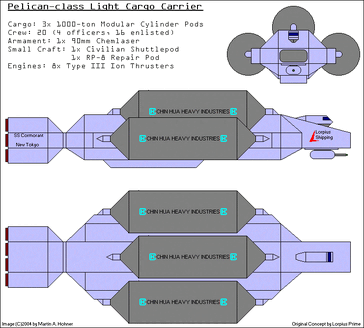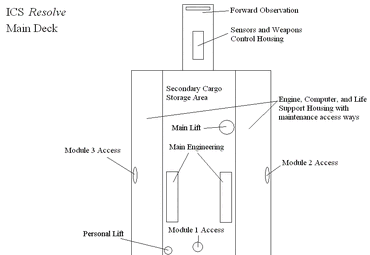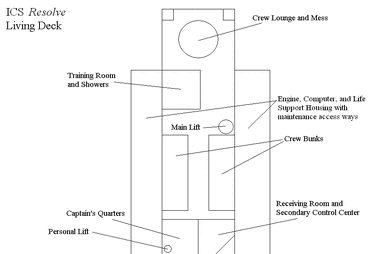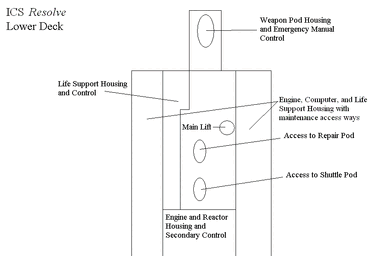mNo edit summary |
(adding link) |
||
| Line 7: | Line 7: | ||
==Structure== |
==Structure== |
||
| − | The Pelican class is basically a central 3-deck hull around which are wrapped 3 conformal mounting points for standard 1000-ton modular cargo containers. These containers are semi-recessed into the hull, and may or may not be pressurized and accessible from inside the hull during the voyage, depending on the type of cargo carried and the degree of privacy desired by its shippers. Eight [[Ion Drive|ion drive]] thrusters at the rear provide propulsion, while a small chin turret housing a single 90mm [[chemlaser]] is the only usual armament. During wartime, a variety of other weapons mounts were often jury-rigged onto Pelicans, as their small size made them tempting targets for conversion into disposable warships to serve in rebel forces or supplement larger navies. These could range from [[Railgun|railguns]] or [[Lance Torpedo|lance torpedo]] [[Box Launcher|box launchers]] in place of the cargo pods, to one case where the crew quarters were moved into the cargo pods to allow a [[Grav Laser]] to be shoehorned into the main hull. On the ventral surface of the hull, a small shuttlebay generally holds either one [[pinnace]], or a small [[CT-8 Courier|shuttlepod]] and even smaller [[RP-12|repair pod]]. |
+ | The Pelican class is basically a central 3-deck hull around which are wrapped 3 conformal mounting points for standard 1000-ton modular [[Cargo Pod|cargo containers]]. These containers are semi-recessed into the hull, and may or may not be pressurized and accessible from inside the hull during the voyage, depending on the type of cargo carried and the degree of privacy desired by its shippers. Eight [[Ion Drive|ion drive]] thrusters at the rear provide propulsion, while a small chin turret housing a single 90mm [[chemlaser]] is the only usual armament. During wartime, a variety of other weapons mounts were often jury-rigged onto Pelicans, as their small size made them tempting targets for conversion into disposable warships to serve in rebel forces or supplement larger navies. These could range from [[Railgun|railguns]] or [[Lance Torpedo|lance torpedo]] [[Box Launcher|box launchers]] in place of the [[Cargo Pod|cargo pods]], to one case where the crew quarters were moved into the cargo pods to allow a [[Grav Laser]] to be shoehorned into the main hull. On the ventral surface of the hull, a small shuttlebay generally holds either one [[pinnace]], or a small [[CT-8 Courier|shuttlepod]] and even smaller [[RP-12|repair pod]]. |
===Main Deck=== |
===Main Deck=== |
||
Latest revision as of 19:36, 20 November 2013

Click for full size
The Pelican class of small cargo freighters was manufactured by theHarrington Industries shipyards on St. Michael's Star in the 2220's and 2230's. They were a common sight on the spacelanes of the Earth Federation, Eastern Bloc, and throughout known space for the next several decades.
Role[]
These light freighters played a role in the Galactic economy somewhere between Semi-Trucks and Tramp Steamers back on pre-space Earth. They have small crews of a dozen or two crewmembers, and carry containerized cargo from place to place. Not really designed for atmosphereic travel, they generally load and unload cargo at orbital tranfer stations. They are technically capable of landing at surface landing fields on planets, but the immense fuel cost of fighting your way that far into and back out of a gravity well generally restricts surface landings to periodic maintenance overhauls or for delivering very high-value cargo.
Structure[]
The Pelican class is basically a central 3-deck hull around which are wrapped 3 conformal mounting points for standard 1000-ton modular cargo containers. These containers are semi-recessed into the hull, and may or may not be pressurized and accessible from inside the hull during the voyage, depending on the type of cargo carried and the degree of privacy desired by its shippers. Eight ion drive thrusters at the rear provide propulsion, while a small chin turret housing a single 90mm chemlaser is the only usual armament. During wartime, a variety of other weapons mounts were often jury-rigged onto Pelicans, as their small size made them tempting targets for conversion into disposable warships to serve in rebel forces or supplement larger navies. These could range from railguns or lance torpedo box launchers in place of the cargo pods, to one case where the crew quarters were moved into the cargo pods to allow a Grav Laser to be shoehorned into the main hull. On the ventral surface of the hull, a small shuttlebay generally holds either one pinnace, or a small shuttlepod and even smaller repair pod.
Main Deck[]

click for full size
On the uppermost of the three decks, the bow of the ship holds the main bridge and forward observation windows. These windows are generally used only in docking with space stations, or in takeoffs and landings on planetary surfaces. In open space they are usually covered with particle shielding for safety reasons. Behind the bridge in the main hull is a secondary cargo area, which is usually filled with supplies and provisions for the crew, but is occasionally used for small amounts of paying cargo, such as bulk mail. Behind that is the main engineering and systems control area, with life support mechanisms and other machinery spaces along the sides. Small access ducts provide maintenance and repair access to the guts of such machinery on both sides of the hull. Also on this deck are the hatchways to provide in-flight access to the cargo modules, if that is relevant to the cargo on board.
Living Deck[]

Below the main deck is the Living Deck, which houses crew quarters, a crew mess/lounge beneath the bridge, an exercise/training room, shower and toilet facilities, and additional life support machinery spaces and access tunnels. The rear of this deck houses the Captain's Quarters and a reception room/Officer's Mess.
Lower Deck[]
The lowest deck on the ship houses the machinery for the chin turret and main forward sensor array at the bow, with the ship's main computer, Engines, and Reactor control room taking up most of the rest of the pressurised space of the hull on this level. Additionally, access to the small craft docked in the huttlebay is via this level. The shuttlebay itself is usuaully open to vacuum, with access via docking tube

click for full size
hatches rather than a hangar-style system seen on larger ships. In emergencies, the shuttlebay CAN be pressurized to allow work on the external surfaces of the small craft in a shirtsleeves environment, but such maintenance is usually carried out at a space station between missions.
Season Eight Alternate Timeline[]
The ICS Resolve, owned and captained by James Welthammer, was a Pelican-class vessel. After it was destroyed, he acquired the SS Polaris as its replacement.
Behind the Scenes[]
This class was originally designed by Lorpius Prime and Martin Hohner, specifically to be the ship of James Welthammer. It was partly inspired by the Gemini Freighter from the original Battlestar Galactica.